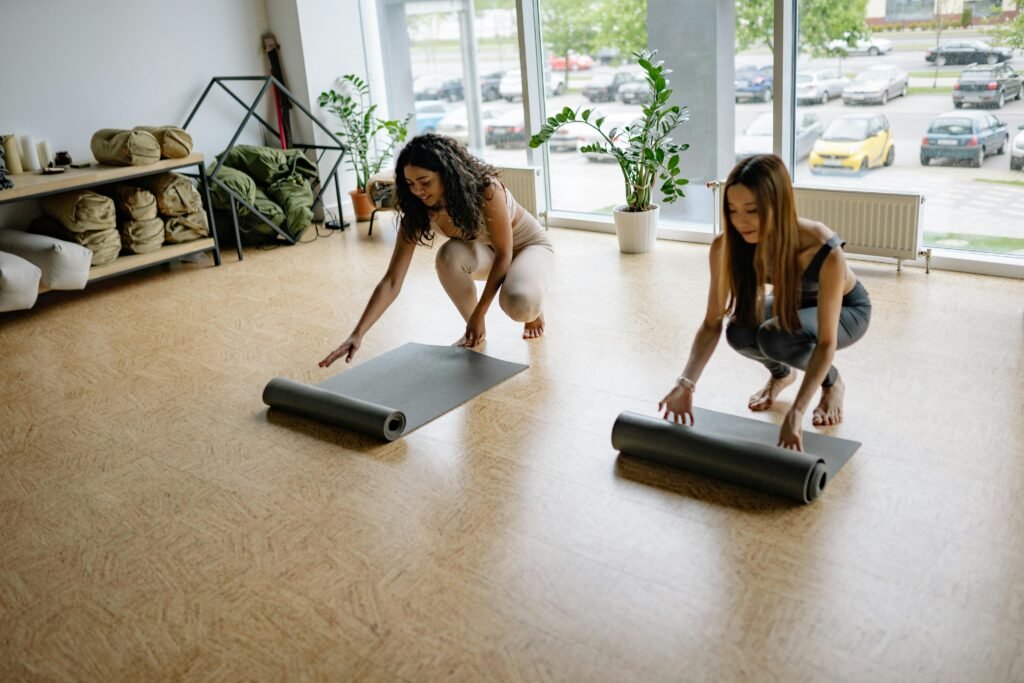
Staying active during pregnancy is not just a recommendation—it’s a pathway to better health for you and your baby. Regular exercise during pregnancy can enhance your physical well-being by improving posture, reducing common discomforts such as back pain and swelling, and boosting energy levels. It also plays a significant role in maintaining healthy weight gain, improving sleep quality, and reducing the risk of gestational diabetes and other complications. Beyond physical benefits, exercise can uplift your mood, reduce stress, and help you feel more connected to the changes your body is experiencing, making the journey of pregnancy more enjoyable and empowering. For moms-to-be looking for comfortable and stylish activewear, the Fashmama Maternity Collection offers versatile options designed to support your fitness journey with ease and elegance.
However, knowing how to approach exercise during pregnancy is key to staying safe and getting the most out of your routine. It’s important to understand which types of exercises are suitable for your trimester, how to modify intensity levels as your body changes, and when to consult your healthcare provider. Whether you’re a fitness enthusiast or new to exercising, this blog will provide practical advice on incorporating safe, effective workouts into your daily life. By understanding the what, why, how, and when of pregnancy fitness, you’ll be better equipped to support your body through this incredible phase of life while preparing for a smoother labor and recovery.
Why exercise during pregnancy?
Exercise during pregnancy goes beyond maintaining fitness; it plays a pivotal role in enhancing physical and mental well-being. Regular physical activity boosts circulation, alleviates common discomforts like back pain and swelling, and strengthens muscles essential for carrying the extra weight of pregnancy. It also promotes better posture, reducing strain on the body and minimizing the risk of complications such as gestational diabetes and preeclampsia. Moreover, exercise releases endorphins, the body’s natural mood elevators, which help combat stress, anxiety, and depression, leaving expectant mothers feeling more positive and energized. At Fashmama, we champion the importance of staying active during pregnancy, offering apparel that combines comfort and style to support every step of this incredible journey.

Beyond physical benefits, exercise during pregnancy fosters emotional resilience and a deeper connection with the growing life within. Activities like prenatal yoga or swimming not only improve balance and reduce fatigue but also offer moments of mindfulness, allowing mothers to bond with their baby through focused breathing and relaxation. Social activities such as group fitness classes create a supportive community, offering opportunities to share experiences and receive encouragement from other expectant mothers. In essence, staying active nurtures both body and mind, empowering women to embrace their pregnancy journey with confidence and vitality while paving the way for a healthier postpartum recovery.
1. Boosts Mood
Pregnancy often brings a whirlwind of emotions, and exercise can play a transformative role in balancing these emotional shifts. Engaging in physical activity stimulates the release of endorphins—your body’s natural mood boosters—helping to alleviate stress, anxiety, and symptoms of depression that may arise during this time. Regular movement, such as a calming prenatal yoga session, not only enhances mindfulness but also promotes relaxation, allowing you to feel more in control and at peace. Even something as simple as a daily walk provides a refreshing change of scenery, which can uplift your mood and offer a sense of accomplishment. By incorporating exercise into your routine, you create a positive outlet for emotional fluctuations, enabling you to embrace pregnancy with clarity, focus, and a greater sense of well-being.
2. Improves Sleep
As your baby bump grows, getting a good night’s sleep can become increasingly challenging, but incorporating regular exercise into your routine might be the solution you need. Physical activity helps alleviate common pregnancy discomforts such as back pain, muscle tension, and leg cramps, which are often the culprits behind restless nights. Gentle exercises like prenatal stretching, yoga, or light aerobics improve circulation and relax strained muscles, making it easier for your body to unwind before bedtime. Exercise also helps regulate hormones and reduces stress, creating a sense of calm that can enhance sleep quality. By staying active, you not only prepare your body for the physical demands of pregnancy but also set the stage for more restful and rejuvenating sleep, ensuring you wake up feeling refreshed and ready to embrace the day ahead.
Read More: Nurturing Yourself During Pregnancy: Caring for Your Body, Mind, and Soul
3. Increases Energy
Pregnancy often brings bouts of fatigue, but staying active is a powerful way to combat this and boost your energy levels. Regular exercise improves blood circulation, ensuring oxygen and essential nutrients are efficiently delivered throughout your body, which helps reduce feelings of lethargy. Strengthening your muscles through physical activity not only supports your growing body but also enhances your stamina, making everyday movements and tasks less exhausting. Exercise also reduces stress hormones like cortisol, which can deplete energy, while increasing the production of endorphins, leaving you feeling refreshed and uplifted. Engaging in light activities such as swimming, walking, or even a gentle dance class can invigorate your body and mind, helping you maintain vitality and tackle daily responsibilities with greater ease and enthusiasm.
4. Prepares for Labor
Labor is one of the most physically demanding experiences, and regular exercise during pregnancy can prepare your body to meet this challenge with strength and resilience. Activities like prenatal yoga, squats, and pelvic floor exercises target the core and lower body, building the endurance and flexibility necessary for labor and delivery. These exercises strengthen key muscles involved in childbirth, such as the pelvic floor, helping to support the baby during delivery and potentially reducing the likelihood of tears or interventions. Additionally, consistent exercise improves overall stamina, enabling you to better handle the physical demands of labor, while promoting better control over breathing and relaxation techniques, which can alleviate pain and stress.
Choosing the Right Exercises
Before diving into a fitness routine during pregnancy, it’s essential to prioritize safety and listen to your body. Pregnancy is a time of profound changes, and what worked for you before might not be suitable now. If you’re new to exercise, it’s important to start gently and gradually build up your activity level. Even if you’re starting later in your pregnancy, it’s never too late to begin incorporating low-impact exercises that support your health and well-being. Here are some pregnancy-friendly exercises that can help you stay active and fit while ensuring safety for both you and your baby:

- Walking: One of the simplest and most joint-friendly exercises, walking is a great way to boost circulation and improve cardiovascular health. Whether it’s a brisk walk around your neighborhood or a gentle stroll in the park, walking helps maintain your fitness levels without putting excessive strain on your body. Plus, it’s a great way to get some fresh air and clear your mind.
- Swimming: Swimming offers a fantastic full-body workout, thanks to the soothing buoyancy of water that supports your weight and minimizes joint stress. The resistance of water makes each movement more effective, while the cool environment can help you feel more comfortable during those warmer months. Swimming strengthens muscles, improves flexibility, and increases endurance without putting too much strain on your body.
- Prenatal Yoga: Prenatal yoga is an excellent choice for maintaining flexibility, building strength, and preparing your body for labor. It helps improve posture, promotes relaxation, and teaches you breathing techniques that will be helpful during delivery. The gentle stretches also relieve pregnancy-related discomforts like back pain, and the focus on mindfulness can help reduce stress and anxiety.
- Strength Training: Using light weights or resistance bands is a great way to maintain muscle tone and improve your overall strength during pregnancy. These exercises help you maintain muscle mass while minimizing the risk of injury. Focus on low-resistance, high-repetition routines, and always ensure proper form. Strength training can also help alleviate the physical strain of carrying extra weight as your pregnancy progresses.
- Pelvic Floor Exercises: Pelvic floor exercises, such as Kegels, are crucial during pregnancy. These exercises help strengthen the muscles that support your bladder, uterus, and bowels. They can assist with childbirth by improving muscle control and reducing the risk of incontinence post-delivery. Incorporating pelvic floor exercises into your routine can enhance your pregnancy experience and help prepare your body for labor.
Exercise by Trimester
As your pregnancy progresses, your body goes through various changes that affect your physical capabilities and needs. That’s why it’s important to adjust your workout routine to each trimester, focusing on exercises that are both safe and beneficial for your health and your baby. Here’s a breakdown of how to approach exercise throughout each stage of your pregnancy:
First Trimester: Start Slow and Focus on Low-Impact Activities
The first trimester is often marked by fatigue, nausea, and significant hormonal changes. During this time, it’s important to listen to your body and prioritize low-impact activities that are gentle on your body while still helping you stay active. Walking, swimming, and yoga are excellent choices during this phase. These exercises increase circulation, improve flexibility, and help reduce pregnancy-related discomforts like back pain and swelling without overexerting yourself.
If you were already active before pregnancy, you may be able to continue moderate cardio exercises such as jogging, but only with the approval and guidance of your doctor. It’s essential to avoid high-impact exercises that could strain your joints, and remember that your energy levels may fluctuate, so take it easy on days when you feel more fatigued. Focus on listening to your body and engaging in activities that make you feel good, allowing you to maintain a healthy, active lifestyle throughout your first trimester.
Second Trimester: Building Strength and Endurance
The second trimester is often referred to as the “golden period” of pregnancy, as many women experience an energy boost and relief from early pregnancy symptoms. With this newfound energy, you can safely ramp up your exercise routine while continuing to focus on low-impact activities. Walking, swimming, and yoga remain great choices, but this is also an ideal time to incorporate light strength training.
Strength training with light weights or resistance bands can help maintain muscle tone and improve your overall strength, which is important as your body continues to change. Prenatal yoga and Pilates are also fantastic for maintaining flexibility, improving core strength, and supporting your posture, which can alleviate pressure on your back as your baby bump grows. During the second trimester, your body will likely feel more stable, and your ability to perform a wider range of exercises should increase, but always check in with your doctor to ensure you’re staying within safe limits for your pregnancy.
Third Trimester: Modify and Prioritize Comfort
By the third trimester, your body will experience more significant physical changes, and you may find certain activities more challenging. As your baby grows, you might feel more fatigued and experience discomfort in areas like your back, hips, and legs. During this phase, it’s essential to modify your workout routine to suit your changing body. Focus on activities that are gentle, such as walking, swimming, and gentle yoga. These exercises will help keep you moving while preventing excessive strain.
Strength training should also be modified during the third trimester. If you’ve been using weights, switch to lighter resistance to avoid overexerting your muscles. It’s important to avoid exercises that require lying on your back, as this can put pressure on your vena cava (the large vein that returns blood to your heart), which could lead to dizziness or discomfort. As your due date nears, always rest when you need to, and don’t push yourself too hard—your body needs time to recharge for the upcoming labor.
Conclusion
Exercise during pregnancy is a powerful way to support both your physical and mental well-being, from boosting energy and mood to preparing your body for labor. By focusing on low-impact activities like walking, swimming, and prenatal yoga, you can stay active and healthy throughout each trimester, adjusting your routine as your body changes. Remember to consult your healthcare provider and listen to your body to ensure your workouts are safe and effective. Whether you’re just starting or looking for comfortable and stylish maternity wear, Fashmama’s Collection offers the perfect blend of comfort and support for all your fitness and everyday needs during pregnancy. Stay active, feel empowered, and embrace this beautiful journey with Fashmama by your side.

